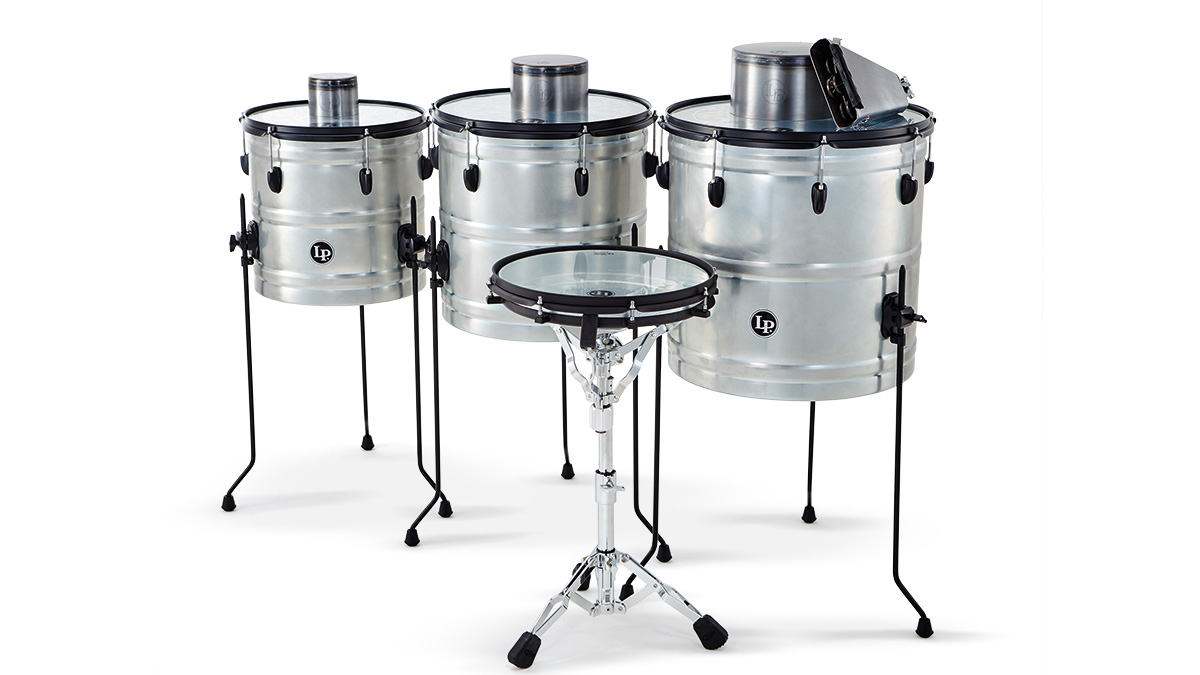MusicRadar Verdict
A hit and miss bag of tricks here from LP. There is some novelty to be enjoyed but the price tags seems tricky to justify considering the nature of the instruments.
Pros
- +
Some interesting sounds.
Cons
- -
Limited practical use.
MusicRadar's got your back
American percussion giant LP has been a world leader in its field for decades.
Producing only bongos and cowbells in the early years, the company has since developed to provide an enormous range of hand percussion and kit add-ons, including its popular Jam Blocks and Ridge Rider cowbells. With the release of the Raw Series, LP attempts to tap into the street drumming market in a Stomp-esque, industrial percussion kind of a way.
Build
Designed as a stand-alone percussion set-up or as a selection of add-ons for the experimental kit player, the Raw Series line-up consists of three main components.
Firstly, we'll look at the Street Cans, which form the bulk of the collection. These 1mm ribbed steel shells are available in 14", 16" and 18" diameters, all with a 16" depth. Closely resembling large metal beer barrels, their resonant head-free design is intended to deliver "thunderous punch and explosive power".
The floor-tom style drums feature extra long, height adjustable legs designed to allow playing from a standing or seated position (up to 36" height).
Next up, 'Potz' are a cheeky play on a street performer's favourite. Simple in concept, imagine a saucepan with the handle replaced by a mounting bracket and you've got yourself a pot.
"The prize for the most unusual component has to go to the 'Trash Snare'."
The melodically pitched Potz are available in 4", 6" and 8" diameters and are finished with a brushed steel appearance, much like the Street Cans. They have a heavy gauge steel construction with a spun steel top and are left with a rustic, welded aesthetic.
They use LP's spring-loaded, self-aligning mounting system which will fit standard mounting rods or stands up to 1⁄2" diameter.
The prize for the most unusual component has to go to the 'Trash Snare'. This is an actual galvanised steel dustbin lid that has been transformed into some kind of bizarre timbale-type instrument using a 14" flanged hoop and a tuneable Remo head, then filled with synthetic beads.
The snare is designed to be played on both sides or used as an enormous shaker, offering a plethora of tonalities and effects. Other elements of the Raw Series include the Jangle Bell (a classic Ridge Rider cowbell with internally mounted nickel-plated steel tambourine jingles) and LP's new Sound Enhancers. The Sound Enhancers are small percussion instruments modelled to clip onto any flanged hoop magnetically. They are available in three options: Jingle, Shaker and Snare Wire.
Hands On
Let's begin with the Potz. You may or may not be surprised to discover that they sound uncannily similar to the type of ordinary pots and pans that you might find in your kitchen cupboard.
Admittedly, it's unlikely that your Tefal saucepans have been pitch-matched to quite such a degree but we'd wager it would be tricky to tell much difference.
The smallest 4" pot sounds decidedly choked in comparison to the 6" and 8" versions which each have a more lengthy decay. The larger pot has a welded metal tab for use with the magnetic Sound Enhancers, which is a useful touch.
The Sound Enhancers are a lot of fun to experiment with, not only with the Raw set-up but also a regular drum kit. With each type bringing its own sonic characteristic to the table, they also all have something in common: they apply a lot of pressure to the drum head which dampens the sound quite considerably.
This can have its advantages of course and work particularly well with the jingle add-on for producing drum'n'bass or funk-style sounds on the snare. Using them on the toms though we find to be fairly unsuccessful.
The Street Cans come tuned extremely low and sound absolutely enormous. They provide an instant attack and create a gut-rumblingly deep note, particularly the larger 18" model.
These could be most useful as a Surdo-style drum within a street ensemble or as a replacement/additional floor tom for a regular kit.
Tuning the cans up a little gives them a more rounded tone and reduces the prominent slap from the batter heads. But priced between £210 and £248 it seems incredibly difficult to justify the money.
Wanting so desperately to enjoy the Trash Snare for its sheer novelty value, unfortunately, we just can't get on with it. The drum offers surprisingly little resonance and sounds fairly dead to the touch.
This is likely caused by the lack of resonant head, replaced here of course by a rather thick dustbin lid. The most agreeable sound we are able to find is to absolutely crank the head and play rim-shots, timbale style. Even then, the ball bearings inside seem to clutter the sound instead of enhancing it. Turning the snare over to try the underside is even less inspiring.
Tom is a professional drummer with a long history of performing live anywhere from local venues to 200,000 capacity festivals. Tom is a private drum tutor, in addition to teaching at the BIMM Institute in Birmingham. He is also a regular feature writer and reviewer for MusicRadar, with a particular passion for all things electronic and hybrid drumming.
“Wendy Carlos is able to build precisely the sound that she wants”: Watch synth pioneer Wendy Carlos in the studio, working Moog magic back in 1989
“It was originally called Everybody Wants To Go To War, which I knew didn’t work. When you’re a songwriter who doesn’t like the lyric, the song dies”: How Tears For Fears created an ’80s mega-hit
“No real sense of love coming from the festival toward the people… Just vibes curated for influencer culture”: Reggie Watts just summed up everyone's Coachella experience











